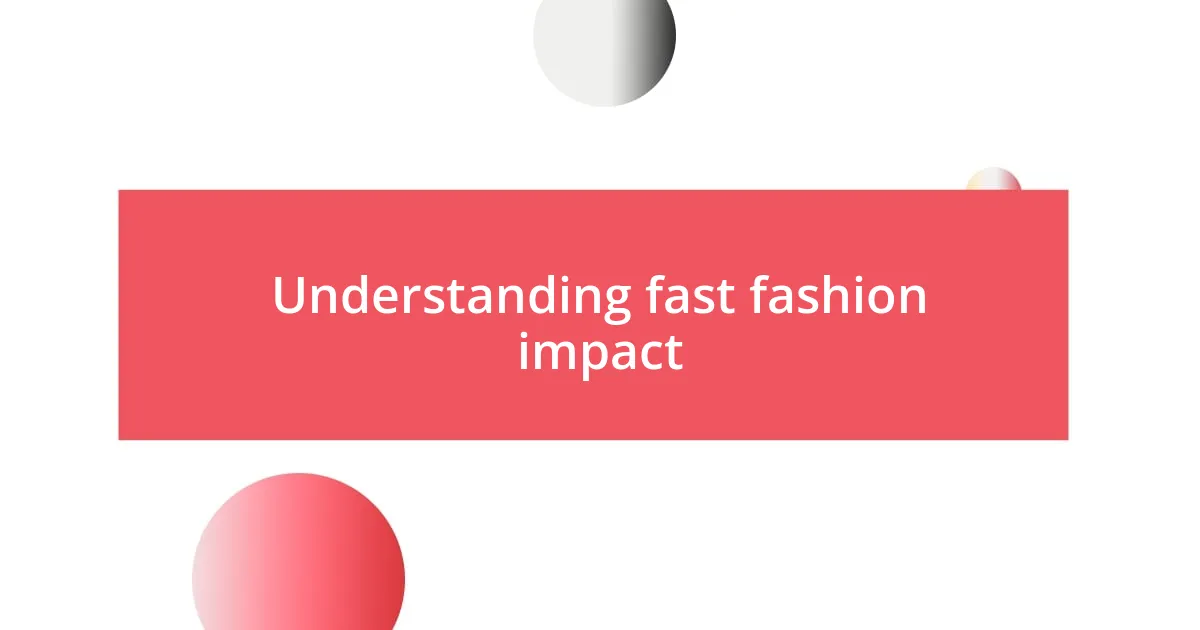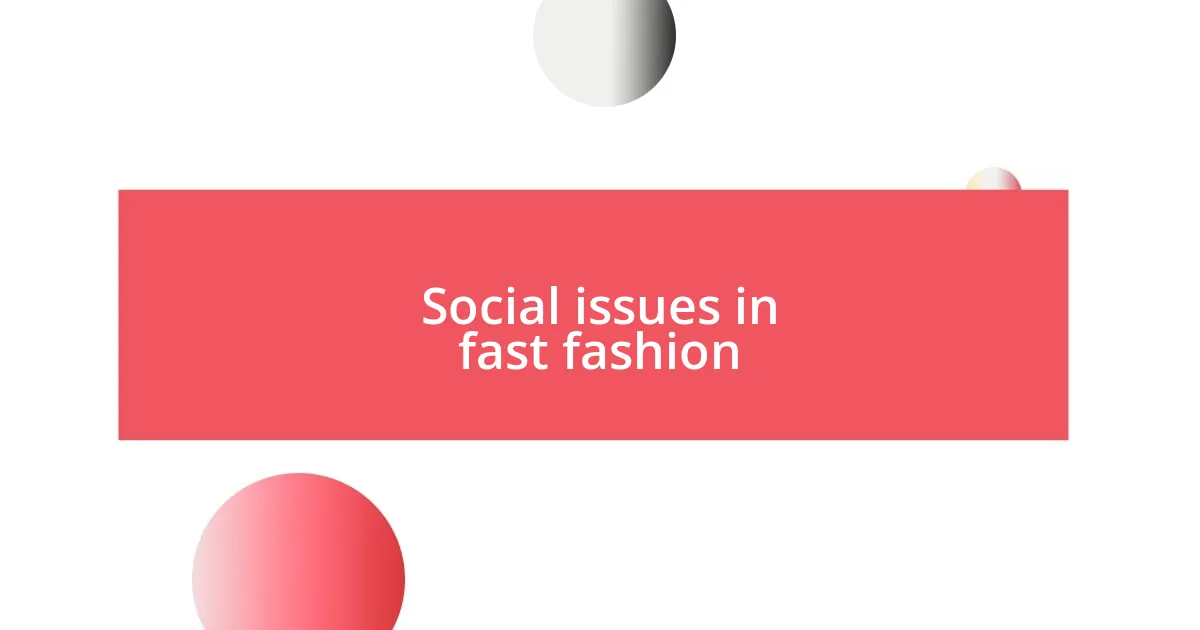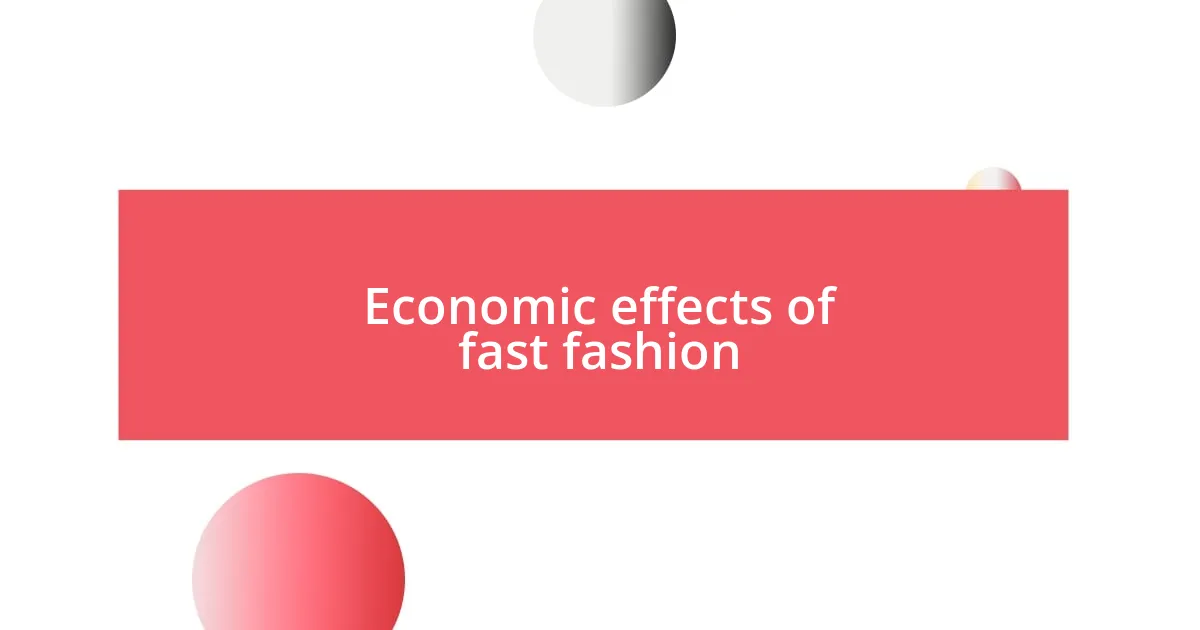Key takeaways:
- The fast fashion industry leads to significant environmental issues, such as textile waste, water pollution, and a large carbon footprint.
- Socially, fast fashion exploits workers in developing countries, often subjecting them to poor conditions and low wages, predominantly affecting women.
- Embracing sustainable alternatives like thrift shopping, eco-friendly brands, and clothing rentals can help shift consumer habits away from fast fashion.
- Future fashion sustainability requires transparency, technological innovation, and a focus on circular fashion to minimize waste and empower consumers.

Understanding fast fashion impact
Fast fashion has a profound impact on both the environment and society. I remember when I used to buy trendy clothes every few weeks, prioritizing style over sustainability. Looking back, I realize how that habit contributes to massive textile waste, with discarded clothes piled up in landfills, often taking years to decompose. Doesn’t it make you wonder where those clothes end up after we’ve outgrown them?
Beyond waste, the fast fashion industry often exploits workers in developing countries, who endure poor working conditions for minimal pay. I once had a conversation with a friend who traveled to Bangladesh and shared stories of sweatshops, where employees worked long hours for almost nothing. It made me reflect on the true cost of that trendy blouse I purchased without a second thought. Have we become too detached from the realities behind our clothes?
As I dive deeper into the issues surrounding fast fashion, I’m struck by the realization that my personal choices can make a significant difference. When I thrifted my last outfit instead of shopping at a chain store, I felt a sense of pride in supporting more sustainable practices. It raises the question: how can we shift our mindset from chasing trends to embracing more mindful consumption?

Environmental consequences of fast fashion
The environmental consequences of fast fashion are staggering and increasingly hard to ignore. I recall visiting a beautiful coastal area, only to see beaches littered with plastic and textiles—the aftermath of our relentless consumption. This experience opened my eyes to how the fashion industry not only depletes resources but also fills our natural spaces with waste that harms wildlife and ecosystems.
Water pollution is another critical issue tied to fast fashion. Many brands use toxic dyes that leach into waterways, affecting local communities and wildlife. I remember reading an article about a river dyed a vibrant color from a factory discharge; it was both fascinating and horrifying to think that our thirst for trends could cause such destruction. We often don’t see the direct impact our shopping habits have on the planet, but those images linger in my mind, reminding me of the urgent need for change.
Moreover, the fast fashion industry’s enormous carbon footprint is a growing concern. I was shocked to learn that clothing production is a major contributor to greenhouse gas emissions. Last year, I decided to calculate my carbon footprint, and it surprised me to find that my clothing purchases significantly impacted my overall footprint. How could I have overlooked something so crucial?
| Environmental Impact | Consequences |
|---|---|
| Textile Waste | Massive contributions to landfills, taking years to decompose. |
| Water Pollution | Toxic dyes contaminate rivers, harming local ecosystems. |
| Carbon Footprint | Clothing production significantly contributes to greenhouse gas emissions. |

Social issues in fast fashion
Fast fashion weaves a troubling web of social issues that often go unnoticed in the glow of new styles. When I learned about the realities of garment workers—many of whom are young women subjected to exploitative conditions—my heart sank. I once met a woman at a local fair who shared her story of working long hours in a factory for pennies a day. Her bright smile masked a life of hardship, and it struck me how disconnected I had been from the people behind the garments I wore. This made me rethink my shopping habits deeply.
- Worker Exploitation: Many fast fashion brands rely on low-wage labor in developing countries, often subjecting workers to unsafe environments.
- Gender Inequality: The majority of workers in the garment industry are women, who face discrimination and limited opportunities for advancement.
- Lack of Labor Rights: Many factory workers have no union representation, leaving them vulnerable to exploitation without recourse.
As I reflect on this, it seems disheartening that our pursuit of fashion trends can lead to such human suffering. Each purchase carries the weight of someone else’s struggles—stories that deserve recognition. With every new collection that pops up, I can’t help but wonder how I can contribute to a shift toward more ethical practices in the industry.

Economic effects of fast fashion
The economic effects of fast fashion are more complex than most people realize. When I first learned about the role of fast fashion in the global economy, I was taken aback. Many countries rely heavily on the apparel sector for jobs and income, but I couldn’t help but think: at what cost? Fast fashion creates temporary jobs that often come with low wages and no job security, leaving many workers in a precarious position.
Moreover, the constant cycle of trends and discount sales drives a culture of overconsumption, which has a cascading effect on local economies. I once walked through a bustling market in a developing country, where local artisans struggled to compete with the cheap, mass-produced items flooding the market. Their vibrant crafts felt overshadowed by the fast fashion brands that promise new styles at a fraction of the cost. It really hit home for me that our choices directly affect the livelihoods of these artisans, making me consider how I could support more sustainable and ethical practices.
Interestingly, fast fashion is also linked to economic instability. When trends change quickly, retailers often offload unsold inventory at steep discounts, which lowers prices across the board. I remember a time when I snagged a shirt for a mere couple of dollars, feeling pleased with my bargain. But then it dawned on me: what does this do to the value of clothing as a whole? It undermines the worth of quality craftsmanship and fosters a throwaway mentality that ultimately harms both the economy and the environment. Isn’t it time we rethink what we value in our wardrobes?

Sustainable alternatives to fast fashion
Sustainable fashion presents a refreshing alternative to fast fashion, allowing us to make choices that reflect our values. For instance, when I stumbled upon a local thrift store, I was genuinely amazed by the unique pieces available. Each item had a story, and knowing that I was giving a second life to clothing felt like a small victory against mindless consumption. Is it possible that these treasures are not just clothes, but connections to the past?
Another avenue I’ve explored is the world of eco-friendly brands. Many companies are now committed to ethical practices, using organic fabrics and ensuring fair labor conditions. I remember when I decided to invest in a sustainably-made jacket. It wasn’t just the quality that attracted me; it was the knowledge that my choice supported artisans who are treated fairly. The satisfaction I felt every time I wore it made me rethink how I define worth in fashion.
Moreover, the rise of clothing rental services has also caught my attention. It’s thrilling to think I can wear high-end fashion for a fraction of the cost, without contributing to the cycle of overproduction. When I rented a gorgeous dress for a friend’s wedding, I realized that experiences and memories are what truly enrich our lives—not a closet full of unused outfits. Isn’t it time we embrace a wardrobe that prioritizes both sustainability and creativity?

Personal actions against fast fashion
One personal action I took against fast fashion was to commit to a “30 wears” rule, which means I don’t buy a piece of clothing unless I can see myself wearing it at least 30 times. This small mindset shift made me more intentional about my purchases. I recall eyeing a trendy top and imagining it languishing in my closet—a surefire way to waste resources and money. Instead, I invested in quality staples that I cherish and wear frequently, feeling good about my fashion choices.
Another impactful decision was to initiate clothing swaps with friends. Last month, I hosted a swap party, and it was a delightful experience. Not only did we refresh our wardrobes for free, but it also felt like a community effort to combat clothing waste. Sharing those laughs and surprises while digging through each other’s closets made me realize how much fun fashion can be without supporting the fast fashion machine. Isn’t it refreshing to wear something that once belonged to a friend?
Lastly, embracing a minimalistic approach helped me take a stand against fast fashion. I decluttered my closet and found pieces I had completely forgotten about. This process was cleansing, both physically and mentally, and I realized that I didn’t need a vast array of clothes to express my style. Every time I put together an outfit now, I feel a sense of pride, knowing I’m curating my collection in a thoughtful way. How liberating it is to focus on quality over quantity!

Future of fashion industry sustainability
I genuinely believe that the future of fashion will see a strong shift towards transparency and accountability. Companies must prioritize clear communication about their production processes, allowing consumers to make informed decisions. I remember when I stumbled upon a brand that openly detailed its supply chain on its website. I felt an instant connection, knowing that I was supporting a company that values authenticity. Isn’t it comforting to know where your clothes come from?
Moving forward, I envision technology playing a vital role in sustainable fashion. Innovations like blockchain can enhance traceability, enabling consumers to understand the lifecycle of their garments, from raw materials to final product. The first time I heard about digital clothing tags, I felt a surge of excitement. Could this be the key to bridging my passion for fashion with my commitment to sustainability?
As we embrace these changes, the concept of circular fashion is gaining momentum. It encourages a model where clothes are designed to be reused, repaired, or recycled, thus minimizing waste. Last fall, I attended a workshop focused on upcycling old clothes, and it was eye-opening. Transforming a worn-out shirt into a trendy tote bag felt empowering. How rewarding it is to give old pieces a new purpose, extending their life beyond the landfill!













